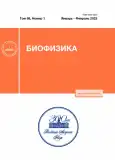Dynamics of temperature and body weight in irradiated mice: the dose-effect and time-effect relationships
- Autores: Zrilova Y.A1,2, Nikitenko O.V1,3, Bychkova T.M1,3, Parfenova I.M1, Karaulova T.A1, Ivanov A.A1,3
-
Afiliações:
- A.I. Burnasyan Federal Medical Biophysical Center of Federal Medical Biological Agency
- N. N. Semenov Federal Research Center for Chemical Physics, Russian Academy of Sciences
- Institute of Biomedical Problems, Russian Academy of Sciences
- Edição: Volume 68, Nº 1 (2023)
- Páginas: 120-124
- Seção: Articles
- URL: https://journals.rcsi.science/0006-3029/article/view/144411
- DOI: https://doi.org/10.31857/S0006302923010131
- EDN: https://elibrary.ru/OAWSHK
- ID: 144411
Citar
Texto integral
Resumo
Palavras-chave
Sobre autores
Yu. Zrilova
A.I. Burnasyan Federal Medical Biophysical Center of Federal Medical Biological Agency;N. N. Semenov Federal Research Center for Chemical Physics, Russian Academy of Sciences
Email: uzrilova@gmail.com
Москва, Россия
O. Nikitenko
A.I. Burnasyan Federal Medical Biophysical Center of Federal Medical Biological Agency;Institute of Biomedical Problems, Russian Academy of SciencesМосква, Россия
T. Bychkova
A.I. Burnasyan Federal Medical Biophysical Center of Federal Medical Biological Agency;Institute of Biomedical Problems, Russian Academy of SciencesМосква, Россия
I. Parfenova
A.I. Burnasyan Federal Medical Biophysical Center of Federal Medical Biological AgencyМосква, Россия
T. Karaulova
A.I. Burnasyan Federal Medical Biophysical Center of Federal Medical Biological AgencyМосква, Россия
A. Ivanov
A.I. Burnasyan Federal Medical Biophysical Center of Federal Medical Biological Agency;Institute of Biomedical Problems, Russian Academy of SciencesМосква, Россия
Bibliografia
- Г. Д. Селидовкин и А. В. Барабанова, Радиационная медицина. Том II. Радиационные поражения человека (ИздАТ, М., 2001).
- П. Д. Горизонтов, В. А. Разоренова, М. Ф. Сбитнева и др., Радиационная биология. Радиоэкология, 57 (5), 529 (2017).
- Ю. А. Зрилова, Т. М. Бычкова, Т. А. Караулова и др., Бюлл. эксперим. биологии и медицины, 173 (5), 643 (2022).
- Y. Kawakami, R. Sielski, and T. Kawakami, J. Visual. Exp., (139), e58391 (2018).
- Н. Г. Даренская, Радиационная медицина. Том I. Теоретические основы радиационной медицины (ИздАТ, М., 2004).
- K. Tanigawa, J. Radiat. Res., 62 (1), i15-i20 (2021).
- J. Terrien, M. Perret, and F. Aujard, Front. Biosci. (Landmark Ed.), 16 (4), 1428 (2011).
- В. Н. Мальцев, Количественные закономерности радиационной иммунологии (Энергоиздат, М., 1983).
Arquivos suplementares









